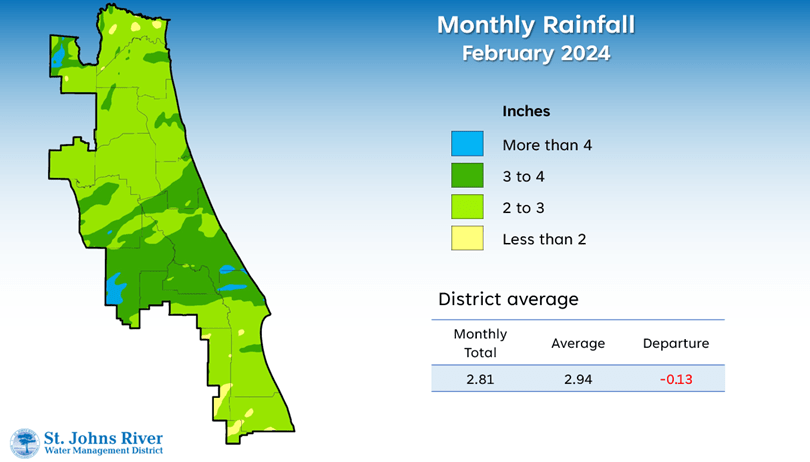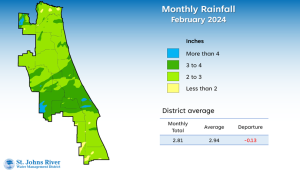Rainfall recap: Below-average rainfall in February for the District

A map illustrates rainfall conditions in February across the St. Johns River Water Management District.
PALATKA, Fla., March 12, 2024 — In February, the St. Johns River Water Management District region witnessed below-average rainfall, with the majority of precipitation concentrated in the middle of the month, driven by a frontal boundary traversing the central counties. Out of the 18 counties comprising the District, 12 received less than their typical monthly rainfall, while six counties experienced above-average precipitation.

A map illustrates rainfall conditions in February across the St. Johns River Water Management District.
A comprehensive report outlining February’s hydrologic conditions was presented at the District’s Governing Board meeting, featuring the following highlights:
Rainfall
- Districtwide, February’s rainfall averaged 2.81 inches, just 0.13 below the monthly average.
- County-wide monthly rainfall totals ranged from a high of 3.79 inches in Lake County, to a low of 2 inches in Okeechobee County.
- Over the past 12 months, the majority of the District received average to above-average rainfall, with a cumulative total of 57.60 inches, surpassing the long-term average by 6.59 inches.
- County-wide totals varied between 52.84 inches in Lake County to 62.91 inches in Volusia County.
Groundwater
- Upper Floridan aquifer conditions varied but generally fell within the high or normal range by the end of February.
- Districtwide groundwater levels, expressed as a single index, fall within the 84th percentile, which is in the high range for this time of year.
Spring flows
- Silver Springs recorded a mean monthly flow of 701 cubic feet per second (cfs), or 453 million gallons per day (mgd), a 13 cfs decrease from January, falling within the normal range for this time of year.
- Blue Spring station in Volusia County reported a mean monthly flow of 158 cfs, or 102 mgd, within the normal range.
- Rock Springs experienced a slight increase in mean monthly flow, just within the high range at 61 cfs (40 mgd).
- Wekiwa Springs exhibited a slight decrease, recording a mean monthly flow of 66 cfs (43 mgd), consistent with the seasonal norm.
For further insights into rainfall totals and other hydrologic data, visit stg-sjrwmd-test.kinsta.cloud.
Visit WaterLessFlorida.com for tips to help landscapes thrive while saving water and money. Follow the water conservation conversation at #sjrwmd #waterconservation #savewater.

